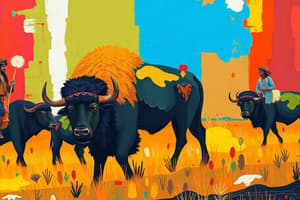Podcast
Questions and Answers
What was a primary factor that influenced the lifestyle of sedentary Native Americans?
What was a primary factor that influenced the lifestyle of sedentary Native Americans?
- Their constant movement in search of new pastures
- Their reliance on fishing as a food source
- Their use of advanced written communication
- Their settlement in villages and farming activities (correct)
Which of the following was not a method of communication used by Native Americans?
Which of the following was not a method of communication used by Native Americans?
- Drawing on hides
- Sign language
- Smoke signals
- Written letters (correct)
How did the introduction of horses impact the lifestyle of Native Americans?
How did the introduction of horses impact the lifestyle of Native Americans?
- It allowed them to become sedentary and stop hunting.
- It forced them into larger, permanent settlements.
- It made them reliant on trading for buffalo meat.
- It provided a more efficient means of transportation and hunting. (correct)
What climate characteristic is associated with summers in the Great Plains?
What climate characteristic is associated with summers in the Great Plains?
Which group of Native Americans hunted buffalo and moved in small bands?
Which group of Native Americans hunted buffalo and moved in small bands?
What type of climate condition was common during spring on the Great Plains?
What type of climate condition was common during spring on the Great Plains?
What was an early method used by Native Americans for communication?
What was an early method used by Native Americans for communication?
Before relying on buffalo, which animal did the Native Americans hunt?
Before relying on buffalo, which animal did the Native Americans hunt?
What role did women primarily play in sedentary Native American communities?
What role did women primarily play in sedentary Native American communities?
Flashcards are hidden until you start studying
Study Notes
Native American Groups
-
Nomadic Groups:
- Relied on buffalo for sustenance and moved frequently.
-
Sedentary Groups:
- Established permanent villages and engaged in hunting along with agriculture.
Utilization of Buffalo
- Buffalo was a central resource for both nomadic and sedentary Native Americans.
- Before the reliance on buffalo, early Native Americans hunted mammoths.
Geographic and Climate Features
- The Great Plains emerged during the Ice Age, serving as a key habitat for indigenous groups.
- European arrival led to the degradation of grasslands.
- Seasonal climate:
- Summer: Hot, dry with thunderstorms and occasional tornadoes.
- Spring: Prone to hailstorms.
- Winter: Characterized by cold temperatures and snowfall.
Social Structure and Hunting Practices
- Small social units called "bands" were formed for communal hunting.
- Hunting strategy involved tracking and hunting buffalo on foot.
- Dogs were utilized to carry goods before the introduction of horses.
Impact of Horses
- Horse domestication significantly improved the lifestyle and efficiency of buffalo hunting.
Gender Roles
- Men primarily responsible for hunting.
- Women played a crucial role in agriculture, specifically in planting corn and beans.
Communication Methods
- To overcome language barriers, Native Americans developed early sign language.
- Smoke signals were another vital means of communication.
- Lacked a written language, so they used hides to create "winter counts" as a form of historical record-keeping.
Skills Development
- Native Americans became adept horse riders, enhancing their mobility and hunting capabilities.
Native American Groups
-
Nomadic Groups:
- Relied on buffalo for sustenance and moved frequently.
-
Sedentary Groups:
- Established permanent villages and engaged in hunting along with agriculture.
Utilization of Buffalo
- Buffalo was a central resource for both nomadic and sedentary Native Americans.
- Before the reliance on buffalo, early Native Americans hunted mammoths.
Geographic and Climate Features
- The Great Plains emerged during the Ice Age, serving as a key habitat for indigenous groups.
- European arrival led to the degradation of grasslands.
- Seasonal climate:
- Summer: Hot, dry with thunderstorms and occasional tornadoes.
- Spring: Prone to hailstorms.
- Winter: Characterized by cold temperatures and snowfall.
Social Structure and Hunting Practices
- Small social units called "bands" were formed for communal hunting.
- Hunting strategy involved tracking and hunting buffalo on foot.
- Dogs were utilized to carry goods before the introduction of horses.
Impact of Horses
- Horse domestication significantly improved the lifestyle and efficiency of buffalo hunting.
Gender Roles
- Men primarily responsible for hunting.
- Women played a crucial role in agriculture, specifically in planting corn and beans.
Communication Methods
- To overcome language barriers, Native Americans developed early sign language.
- Smoke signals were another vital means of communication.
- Lacked a written language, so they used hides to create "winter counts" as a form of historical record-keeping.
Skills Development
- Native Americans became adept horse riders, enhancing their mobility and hunting capabilities.
Studying That Suits You
Use AI to generate personalized quizzes and flashcards to suit your learning preferences.




